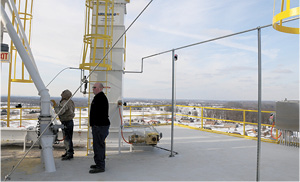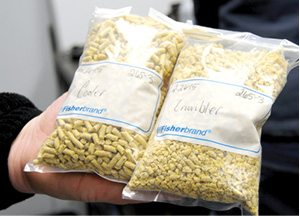Cobb-Vantress feed mill is now fully operational

High times . . .
Above, Cobb Mill Manager Matt Ferguson, right, was inspecting a pipe on the top platform of the mill Friday morning. Ferguson said the colder weather makes it harder to keep the lines flowing smoothly and at times clogged or slow flows are jogged loose with the use of a rubber mallet.
At left, a side by side comparison of crumbled feed, right, and pellet feed that the mill produces. Ferguson said the mill is now fully operational.

Citizens of Clinton and surrounding counties have been keeping an eye on the newly constructed Cobb-Vantress feed mill for more than a year now and although minor construction is still ongoing, the plant is fully operational and producing between eight to 10 trucks of finished feed product per day.
The six-story facility is currently producing feed for Albany and surrounding counties as well as feed for a number of farms in Tennessee.
Matt Ferguson, Feed Mill Manager, said they have been up and running for a while.
“We are just in the touching up phase. We are fully operational right now,” Ferguson said. “We’ve been operational since January 30th. Construction will probably wrap up mid to late March.”
The Cobb Mill produces feed for its poultry houses located in Kentucky and Tennessee.
Ferguson said there are somewhere around 80 farms the mill will provide feed to.
“They used to pull all their feed out of the Seven State Coop out of Park City, Kentucky,” Ferguson said. “We go all the way down to Sparta, Tennessee. We have a pretty large area that we cover.”
One of the key factors to the Cobb Feed Mill is keeping the feed sanitary.
In the building closest to KY Hwy 1590, with a red roof, is a truck washing facility.
Ferguson said drivers pull through and get their trucks cleaned before pulling into the feed mill.
“It’s an automated system. When the trucks come back from the farms they get washed and disinfected,” Ferguson said. “They just open the door and they pull their way through. All of our farms are bio-secure facilities so all the truck drivers shower in during the morning before they get in their truck.”
Ferguson said the main goal for building this facility is to produce salmonella free feed.
“There are strict controls to everything we do here,” Ferguson said.
In addition to providing feed to Cobb farms, the facility also buys local crops in order to produce the feed.
“All of our corn is coming from the Clinton County/Wayne County area,” Ferguson said. “That’s about the only raw ingredient we use. Everything else is processed.
The economic benefit for this area is two-fold, giving local farmers a nearby market for their corn product without having to travel in order to sell corn, in addition to providing additional jobs.
“They used to have to drive to Franklin, Kentucky,” Ferguson said. “It’s going to be a big help to the county.”
The tower stands 168 feet above ground and there are several different areas inside the tower the produce goes to before loaded into the trucks.
“We have about 40,000 bushels of storage for whole corn, then we grind it into cornmeal,” Ferguson said. “After it’s ground into cornmeal then we make it into pellets.”
Ferguson said they can produce feed individual for each farm depending on what is needed at each farm.
“We can turn it into pellets or we can grind it up for baby chicks … whatever they need,” Ferguson said.
In order to keep the mill and its feed sanitary, Ferguson said there are several different ways they do it and a couple have never been used before in a feed mill.
Most clean areas are controlled by airflow. When the feed comes into the mill it is kept in pressurized rooms. With salmonella being able to travel through the air, controlled airflow and dust collection are key factors in preventing the disease from spreading.
After the corn is dumped into the dump pits, a dustless pit system vacuums up the plume of dust produced while unloading.
Once the grinding and mixing are complete, the pathogen treatment process starts with a 500 horsepower pellet mill with a hot start feature, pre-heating the feed.
As the feed is heated, it heads to the conditioner and the heat is held at 185 degrees for 45 seconds. Then it’s dropped into a 48-inch Hygenizer and held at a temperature of 185 to 190 degrees for five minutes. This ensures all bacteria and pathogens are killed.
The Cobb Feed Mills has the capacity of producing 3,000 tons of feed with 80 hours per week of operation, however, it will be running around 2,000 tons per week on a 40 hour-week schedule.
Cobb Feed Mill also employees 15 for the area, including six truck drivers.



